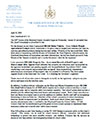Dear Constituent of 35 B:
The 437th Session of the Maryland General Assembly began on Wednesday, January 11 and ended Sine Die, April 10 at midnight as prescribed by law.
I sponsored HB 664-State Government-Display of the POW/MIA Flag on State Building Grounds which passed both Houses of the General Assembly and is on the Governor’s desk for his signature. The bill requires the Secretary of General Services and the Secretary of Transportation to cause the POW/MIA flag to be flown on the grounds of all State buildings under their control whenever the U.S. flag is flown as long as it is structurally feasible. “POW/MIA flag” means the POW/MIA flag of the National League of Families of American Prisoners and Missing in Southeast Asia This bill would allow the State to show its support and respect for those service members who have yet to return home and remind the families that their loved ones will not be forgotten. These service members have sacrificed dearly for our country, and this legislation helps Maryland recognize that sacrifice, if only in some small way. Thank you to all those who came to Annapolis to support the legislation.
HB 100-Income Tax Subtraction Modification-Retirement Income of Law Enforcement, Fire, Rescue, and Emergency Services Personnel which I cosponsored allows retirement income to qualify for the State pension exclusion if the individual is at least 55 years old and the retirement income is attributable to employment as a law enforcement officer or as fire, rescue, or emergency services personnel of the United States, the State, or a local jurisdiction. Emergency services personnel includes emergency medical technicians and paramedics. This bill is also on the Governor’s desk for his signature.
The General Assembly passed Governor Hogan’s Fiscal 2018 Budget with few changes made to the Governor’s initial proposal. This budget contained no tax increases while being structurally balanced, and protected important priorities such as K-12 and higher education, environmental programs, and public safety.
The Governor’s Budget provides a record investment in K-12 education. This investment fully funds the mandates set by the General Assembly – every dollar that every jurisdiction in the state anticipates for education is completely funded. The budget also included funds to cap tuition increases to 2%. The Governor’s budget also included an investment of $51 million towards the Chesapeake and Atlantic Coastal Bays Trust Fund, and provided enhanced substance abuse funding.
After the General Assembly’s actions, the overall budget growth was only 1.5% over last year, and leaves over $950 million in reserve, to guard against potential revenue shortfalls over the year. We worked together with Governor Hogan to stop more than 90% of the new proposed mandated spending.
Governor Hogan submitted a Capital Budget that held the line on borrowing but made important investments across our state. As submitted, two-thirds of the Governor’s Capital Budget was dedicated to education projects with dollars also dedicated to revitalization, economic development, and tourism projects across the state. Even with these important investments, the Governor’s Capital Budget submission was cautious. With the massive expansion of borrowing under the previous Administration, debt payments are quickly growing. The revenue that covers those costs comes from the State’s Property Tax and has not been growing at the same rate. This puts pressure on Maryland’s entire budget in the out-years, so restraint is required. The Governor capped borrowing at $995 million in fiscal 2018. The General Assembly exceeded that cap by $70 million.
HB 503-State Budget-Appropriations-Income Tax Revenue Estimate Cap and Revenue Stabilization Account, eliminates the practice of using occasional, temporary revenue spikes to fund known recurring future expenses. During years with a revenue surplus, excess income will automatically be moved into the state’s rainy day fund – this extra revenue will be available to use for years to come when revenues fall short. The Governor’s proposal was incorporated into this bill which passed the House and Senate and was signed by the Governor on March 31st. I fully supported this legislation.
I voted for the Governor’s Common Sense Spending Act of 2017 which would have ensured that future budgets prioritize key expenditures like education and health care, while giving leaders the flexibility to trim excessive cost increases that exceed revenues. Unfortunately, the General Assembly did not pass this initiative.
I voted against HB 1362-Criminal Procedure-Immigration-Community Trust (otherwise known as the Sanctuary Bill) which expressed the intent of the General Assembly to maintain community trust in Maryland governmental operations and law enforcement by
clarifying the parameters of State and local participation in federal immigration enforcement efforts. Thanks to your grass roots efforts, this bill finally was withdrawn before the Senate vote.
SJ 5-Attorney General-Powers-Maryland Defense Act of 2017 is a Joint Resolution of the General Assembly giving the Maryland Attorney General unprecedented power to sue the federal government. This legislation gives the Attorney General power to sue the federal government on any policy he disagrees with. This power is not just limited to challenging Executive Orders, but also measures constitutionally passed by Congress. Because it was a Joint Resolution, the Governor does not have the power to veto the legislation. It was signed by the Speaker of the House and Senate President. I voted against this resolution.
Originally, the Attorney General’s Office said they could perform these tasks with their existing budget. However, the very day the resolutions passed the House, HB 913-Attorney General – Powers-Maryland Defense Act of 2017, a bill which mandates an additional $1 million dollars per year (at minimum) to the Attorney General’s budget to hire up to five additional attorneys to handle lawsuits against the federal government was given a hearing and was subsequently passed by the House and the Senate. I also voted against this bill.
Upon examination, HB 978-Protect Our Schools Act of 2017 weakens accountability standards and creates barriers for the state to intervene in failing schools. Both the Washington Post and Baltimore Sun Editorial boards have come out against the bill, agreeing that it represents more direct meddling by the General Assembly into the state school board’s business than is wise.
The bill bars the State Board of Education from emphasizing student achievement when it establishes this accountability system. It limits the measures of actual school effectiveness, such as student achievement and graduation rates, to only 65% of a school’s accountability rating. The bill instead favors factors such as teacher satisfaction, small class sizes, low teacher-to-student ratios, and a healthy and supportive school culture. Such a low accountability rating makes it more difficult to actually identify schools that are failing. Not only that, but with this bill’s passage, Maryland will have the weakest accountability system in the entire country and risks losing over $248 million per year if these low accountability standards are found to be out of compliance with federal standards.
The most troubling aspect of this bill is that it traps children in failing schools. The bill not only makes it harder to identify failing schools by weakening standards, it also ties the hands of the State Board of Education when it comes to taking measures to get failing schools on track. Students in failing schools are trapped in those failing schools for three years before the State and local school districts are permitted to intervene.
We have a Constitutional and moral obligation to provide a quality education for every child in our state. The pattern of allowing children to languish in failing schools for year after year must end.
The bill passed the House and Senate. Governor Hogan wisely vetoed this legislation, but his veto was overridden. I voted not to support this legislation.
I voted for SB 317-More Jobs for Maryland Act of 2017 which establishes a 10-year income tax credit for specified manufacturing businesses in certain jurisdictions if the businesses increase employment and offer ongoing job skills enhancement training. The bill also (1) establishes an income tax credit for businesses that employ an eligible apprentice; (2) establishes Workforce Development Sequence Scholarships for eligible students who are enrolled in a job skills program at a community college; (3) requires specified vocational goals to be established for high school students; and (4) requires State agencies to analyze and report specified information on registered apprenticeship programs.
Since the start of session, Maryland has added 24,700 new jobs (nearly 25% of the over 100,000 jobs created since the governor took office) – showing that Maryland job creators are pleased with the direction the state is heading and the strong leadership of Governor Hogan.
MARYLAND IS STILL HEADED IN THE RIGHT DIRECTION!
It has been a pleasure to hear from you during the 2017 Session and I have listened to your concerns and opinions before voting. We may not always agree, but I have tried to do what is best for the citizens of Cecil and Harford Counties and the State of Maryland. I enjoyed working with the Hogan Administration to bring to fruition some of the promises that the Governor has made to the people of Maryland. We hope to fulfill more of those promises to small businesses and those people who live in Maryland in the coming sessions.
If you have any questions or concerns during the Interim, please do not hesitate to contact me at Teresa.reilly@house.state.md.us or at 410-841-3278. The Annapolis Office will be open on Tuesdays and Wednesdays from 9-4 if you wish to pay a visit.
Sincerely,
Teresa E. Reilly


